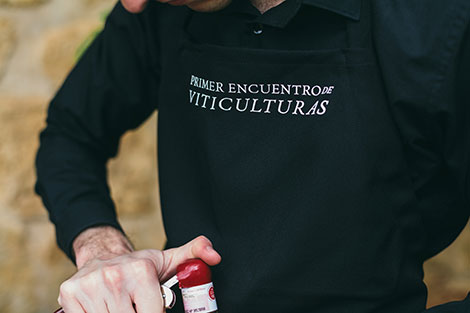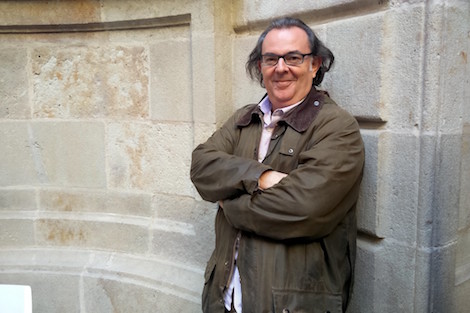
Spanish wine producers are not great at pulling together and leaving aside personal interests for the common good, but the First Wine Growing Encounter held on 15 and 16 May at La Granja Nuestra Señora de Remelluri showed that something is changing.
The encounter, a follow up of the Manifesto Matador in favour of Spain’s wine territory, rural areas and its unique vineyards, was hosted by Telmo Rodríguez. This well-known producer managed to bring together more than 150 professionals and wine enthusiasts, most of them young and devoted growers. Two interesting tasting sessions enlivened the encounter: one of them was led by the producers taking part in the conference whereas the other, more spontaneous and casual, was open to all participants willing to pour their own new creations. The remarkable gathering of so many new wines from different regions was proof of the thriving state of the Spanish wine scene. An atmosphere of excitement was felt throughout the encounter.
In his brief welcome speech, Telmo Rodríguez said he had never liked the Spanish habit of referring to other producers as "competitors" and that doors at Remelluri had always been wide open to culture. He recalled a tasting held at the estate some years ago with Spanish and French wines made along the Camino de Santiago. He recalled how he struggled to find an old Riscal vintage, a rosé from Navarra, a Mencía made by a Co-op in Bierzo and some whites from Valdeorras and Ribeiro. "If it had been done today the tasting would have been much more interesting. Perhaps in 20 years’ time, we will be able to match Clos Vougeot and legendary wines grown on the slopes of Hermitage”, Rodríguez said. “The image people have of Spanish wine does not reflect what we really are. We are responsible for changing this sorry picture we have built up in recent years."
Mirroring the event held at Club Matador last November in Madrid, the encounter was marked both by the high level of the speakers and the audience. The latter included key wine personalities in Spain like Josep ‘Pitu’ Roca, sommelier at 3-Michelin starred restaurant Celler de Can Roca, Juan Carlos Lopez de Lacalle from Artadi, still in the limelight after leaving the DOCa Rioja, or wine merchant Quim Vila from Vila Viniteca. Vila allowed himself a small rap on the knuckles to sommeliers discussing about “how to transmit a fresh, coloquial image of wine in the restaurant" and urged them to reinvent themselves following the example of the new burgeoning wine producers in Spain.
Rich, varied wine growing landscapes
During the two-day gathering, almost 20 producers —all of them committed to their vineyards— shared their experiences showing the power and diversity of landscapes and wine growing traditions in Spain: the unique “multiple cordon” training method used by Suertes del Marqués in Valle de la Orotava (Tenerife, Canary Islands); Algueira’s vine growing work on dizzying slopes in Ribeira Sacra (Galicia); José Luis Mateo’s efforts to claim back the prestige of a remote area like Monterrei; the return to growing vines and trees together done by 4 Kilos in Mallorca; Casa Castillo’s extreme viticulture in sun-drenched Jumilla and the defense of Cava and Sherry as terroir wines championed by Ton Mata (Recaredo) and Eduardo Ojeda, technical director of Grupo Estévez and co-founder of Equipo Navazos together with Jesus Barquín.
Ojeda summed up the general feeling: "We have to talk about wines from places instead of wines from cellars."
Some interesting contributions to the debate included a summary of the work carried out by anthropologist Luis Vicente Elías for a forthcoming atlas documenting viticulture in Spain between 1930 and 1950, likely to be an inspiring source for producers nowadays. Fernando Martínez de Toda, viticulture professor at University of La Rioja, championed traditional bush vines both in practical and quality terms, although he warned that "the price of grapes is the decisive factor in viticulture ". His disciple Pedro Balda, who makes intriguing natural wines in San Vicente de la Sonsierra (Rioja), talked about the recovery of minority grape varieties in order "to put in the limelight grapes which are not yet authorized but which will help to confront global warming and other future challenges."
Environmental expert Antonio Lucio, who previously talked at Club Matador’s round table in Madrid, and architect Albert Cuchí drew a wider picture for winegrowing, linked to sustainability policies and respect for the environment. Cuchí explained that societies live of the exploitation of the territory and reminded everyone that the countryside is as densely built as urban areas: "If the landscape is ugly, it is so because we live in an ugly way and are not using it properly."
Safeguarding the origin
Salustia Álvarez, President of DOQ Priorat, regretted being the sole representative of an appellation in the encounter despite the fact that at least four Regulatory Councils had been invited to attend. Álvarez encouraged participants to think about the role of these bodies: "If appellations are not able to guarantee the origin, we have been doing things wrong over the last 40 years,” he said.
German producers Reinhard Löwenstein and Hansjörg Renholz talked about the VPD, a terroir-driven association with a private classification system developed as a reaction to wine laws approved in the country in the 1970s which classified wines based on their musts sugar content instead of the uniqueness of the vineyards they came from.
Under the title “Spain: A Case of Metathesiophobia” (the word means fear of change), British wine writer Tim Atkin used his recent immersion in Rioja to champion a Burgundy-style classification for Spain’s most famous wine region. Atkin said Rioja was a sleeping lion that should be awaken. “It’s stupid not to be allowed to use village names on the labels,” he argued. “The change is already done and now the people in charge of the appellation have to be persuaded to approve it. Great wines are not made by politicians but by winegrowers,” he concluded.
Both Antoine Graillot, representing the domaine established by his father in Crozes-Hermitage (Rhône), and Eloi Dürrbach from Domaine Trevaillon (Provence) represented an example of established projects that have succeeded despite moving against the tide; in the case of Trevaillon, beyond the borders of an appellation. Dürrbach was especially eloquent answering the request of Juan Carlos López de Lacalle (Artadi) to share a piece of advice with the audience. "I believe in trust and intuition; people must have confidence in their own intuition. The problem is we live in an information society, subject to trends and opinion leaders,” Dürrbach said, whereas Graillot stressed the importance of "creating an identity."
Self-criticism
There were also critical voices at the encounter. Pepe Raventós from Raventós i Blanc said he was somewhat disappointed with the encounter and urged wine growers to create a lobby in view of how insignificant they still were within the wine industry. "In addition to making good wine, a greater awareness of the wine regions is needed," he said.
Hosting one of the round tables, Luis Gutierrez, The Wine Advocate’s man in Spain, noted that "land division is meaningless unless standardized wines disappear; but it won’t be valid either unless wines from different villages succeed at showing specific features."
Daniel Jiménez-Landi, a well-known producer from Gredos both for his own wines and in tandem with Fernando García at Comando G, warned against complacency: "Change must come from the producers. We have the responsibility to honestly express the landscapes in the wines; we must work with the strong conviction that great wines are not ‘made’ but grown. Wine regions don’t emerge from a sole producer but from lots of them.”
As a supporter of the Matador manifesto and having contributed to the design of the encounter’s contents, I particularly enjoyed moderating a round table on viticulture and its role in rural life. While Rioja producers Arturo de Miguel (Artuke) and Roberto Oliván (Tentenublo) warned against the depopulation of rural communities and stressed the need to work full-time in the vineyard to obtain good grapes, the couple formed by Ester Nin and Carles Ortiz showed their commitment to organic and biodynamic agriculture in Priorat and their wish to leave a better world for their children.
The magic of Remelluri
An element that contributed significantly to the success of the encounter was its location. La Granja Nuestra Señora de Remelluri was one of the pioneers in making single-vineyard wines in Rioja after Telmo’s parents, Jaime and Amaya, bought the property in the late 1960s. The estate, on the foothills of the Sierra Cantabria mountains, has a special energy. It’s not by chance that the Hieronymite monks founded a farm serving the Toloño sanctuary in the 14th century.
The property retains traces of agricultural activity since ancient times and the Rodríguez family has been extremely respectful of the environment and its surroundings. In fact, the wine experience visitors find includes various walks and hikes along the over 150-hectare estate.
All of the presentations and round tables took place in the old cellar housing the big, old wooden vats whereas the main tasting was held on the gardens by the beautiful chapel. The event was seamlessly organized by the family with Telmo’s brother, Sancho, and his companion Angela taking the leading role and most family members, children included, helping and acting as excellent hosts.
The al fresco lunch on the vineyards (have a look at the gorgeous pictures above) was magical and arguably the highlight of the encounter. The Rodríguez family aptly managed to create the perfect atmosphere and the stepping stone for producers to start working all together.
Check out all presentations and round tables here.

Amaya Cervera
A wine journalist with almost 30 years' experience, she is the founder of the award-winning Spanish Wine Lover website. In 2023, she won the National Gastronomy Award for Gastronomic Communication
Wine tastings in June 2016
NEWSLETTER
Join our community of Spanish wine lovers






